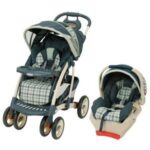The majority of parents, especially first time parents, check the development charts to see how their baby is maturing. Physicians ask at every healthy check up how babies are doing on accomplishing their motor milestones. Gross motor development is one area of development that physicians and parents are constantly checking. Is my baby rolling over on time? Is my baby sitting up on time? And most importantly, is my baby walking on time? There are several strategies that parents can do to encourage gross motor development in babies.
1. Do not constantly place your young baby in the infant car seat. Use the infant car seat only for the car seat. Use a infant carrying system such as a Baby Bjorn where the baby is strapped closely to your body. The baby will experience more movement changes in the baby carrier. Each movement change requires a baby to activate muscles to remain upright.
2. Carry your baby in different positions. When you carry your baby laying down, on your hip or facing forward each position requires the baby to activate different muscles to keep the head upright.
3. Provide your baby with supervised tummy time daily. You need to start young so babies can get used to being on their bellies. Frequently parents think that because babies should not sleep on their stomach that they should not play on their stomach.
4. Get down on the floor and play with your child. Place toys just a little bit out of reach. You baby will have to activate many muscles to get the toy. Babies love to touch and feel their parents faces. Try putting your face and hands again just a tad out of reach so that the baby will have to shift his/ her weight and activate muscles to reach you.
5. Limit propped sitting time. Babies learn the skills to sit from learning to roll, reach and play on their bellies. If you place babies in supported sitting for long periods of time either in a car seat or supported seat (i.e. Bumbo seat) they are not required to activate the muscles necessary to remain upright.
6. Once a baby can sit, it continues to be important to get down on the floor and play with your baby. Place toys slightly out of reach and the baby with shift from side to side, turn at the trunk, reach up high which are all skills that activate many core muscles in the belly and back.
7. Encourage weight bearing activities. Weight bearing activities are any activities where the baby receives input through the joints and muscles resulting in muscle activation. For example, the baby weight bears through the lower arms and hands when playing on the belly. The baby weight bears though the legs and feet when walking. When crawling the baby weight bears through the shoulders, arms, elbows, hands, hips, leg and knees. Now you can see why crawling is considered such an important skill.
8. Make sure that your baby has a safe, comfortable space to play on the floor. Move furniture aside and coffee tables out of the room so that baby can play freely.
9. Avoid frequent use of rolling walkers or supported standing equipment. Babies develop the skill to walk by developing precursor skills such as crawling and kneeling. If a baby is confined to a walker they are unable to develop the skills necessary to walk.
10. Allow your baby ample time to practice all of their skills. Babies learn by repeating the same tasks over and over again. if a baby is confined to any piece of equipment, car seat, high chair, stroller or walker, their practice time diminishes significantly.
One last bonus tip – enjoy your baby and keep it fun. Babies all develop at their own pace but by modifying your babies environment you can encourage gross motor development.






